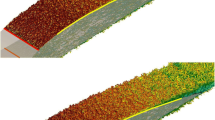Abstract
The generation of aerodynamic forces by a plunging NACA0012 airfoil at a Reynolds number of 20,000 was studied for a range of non-dimensional plunge frequenciesk and amplitudesh using a 2D unsteady compressible Navier-Stokes solver, an unsteady panel method (UPM) and Garrick’s analysis. Calculations using these two methods indicate that the forces collapse reasonably well withkh (or equivalents the Strouhal number), but are only weak functions ofk. In contrast results from the NS code indicate that the forces are dependent on bothk andkh independently, with large variations at low frequencies. The frequency dependence was found to be a result of vortex shedding from the leading edge of the airfoil, and appears to result from two factors. Firstly at high plunge frequenciesk, the leading edge vortex does not have sufficient time to grow, whereas at lowk the vortex can become a sizeable fraction of the airfoil chord before separating. Secondly once the vortex separates, it is convected downstream over the surface of the airfoil. Due to the low pressure in the vortex core, thrust is maintained while the vortex is upstream of the airfoil maximum thickness point (where the airfoil surface is tilted upstream and the vortex low pressure creates an upstream suction force). Once past this point, the airfoil surface is tilted downstream and the vortex contributes to drag rather than thrust. At high plunge frequencies the vortex cannot be convected far downstream before the motion cycle creates another leading edge vortex on the opposite side of the airfoil, so the impact is lessened. At lowk however the vortex travels far downstream over the airfoil surface, causing drag for a larger portion of the flapping cycle, and therefore lower propulsive efficiency. These results have strong implications on how the thrust and the propulsive efficiency can be maximised by controlling the relative amplitudes and phases of combined pitching and plunging motions of an airfoil.
Similar content being viewed by others
References
Anderson, J. M., Streitlien, K., Barrett, D. S. and Triantafyllou, M. S., 1998, “Oscillating Foils Of High Propulsive Efficiency,”Journal of Fluid Mechanics, Vol. 360, pp. 41–72.
Bandyopadhyay, P. R., Castano, J. M., Nedderman, W. H. and Donnelly, M. J., 2000, “Experimental Simulation of Fish-Inspired Unsteady Vortex Dynamics on a Rigid Cylinder,”ASME Journal of Fluids Engineering, Vol. 122(2), pp. 219–238.
Basu, B. C. and Hancock, G. J., 1978, “The Unsteady Motion of a Two-Dimensionai Aerofoil in Incompressible Inviscid Flow,”Journal of Fluid Mechanics, Vol. 87(1), pp. 159–178
Choudhuri, P. G, Knight, D. D. and Visbal, M. R., 1994, “Two-Dimensional Unsteady Leading-Edge Separation on a Pitching Airfoil,”AIAA Journal, Vol. 32(4), pp. 673–680.
Ekaterinaris, J. A. and Platzer, M. F., 1997, “Computational Prediction of Airfoil Dynamic Stall,” inProgress in Aerospace Sciences, Vol. 33, pp. 759–846.
Garrick, I. E., 1937, “Propulsion of a Flapping and Oscillating Airfoil,”NACA Report 567.
Hall, K. C. and Hall, S. R., 2000, “A Rational Engineering Analysis Of The Efficiency Of Flapping Flight,”in Fixed and flapping wing aerodynamics for micro air vehicle applications, edited by T.J. Mueller, AIAA, Reston, VA, pp. 249–274.
Heathcote, S., Wang, Z. and Gursul, I., 2006, “Effect Of Spanwise Flexibility On Flapping Wing Propulsion,” AIAA Paper 2006-2870,36th AIAA Fluid Dynamics Conference and Exhibit, (San Francisco, Ca, 5–8 June, 2006).
Isogai, K., Shinmoto, Y. and Watanabe, Y., 1999, Effects of Dynamic Stall on Propulsive Efficiency and Thrust of Flapping Airfoil,AIAA Journal, Vol. 37(10) pp. 1145–1151.
Jones, K. D., Dohring, C. M. and Platzer, M. F., 1996, “Wake Structures Behind Plunging Airfoils: A Comparison of Numerical and Experimental Results.” AIAA Paper 96-0078,in 34th Aerospace Sciences Meeting and Exhibit (Reno, Nevada, 1996).
Koochesfahani, M. M., 1989, “Vortical Patterns in the Wake of an Oscillating Airfoil,”AIAA Journal, Vol. 27(9), pp. 1200–1205.
Lai, J. C. S. and Platzer, M. F., 1999, “Jet Characteristics of a Plunging Airfoil,”AIAA Journal, Vol. 37(12), pp. 1529–1537.
Lighthill, M. J., 1960, “A Note on the Swimming of Slender Fish,”Journal of Fluid Mechanics, Vol. 9, pp. 305–317.
Schouveiler, L., Hover, F. S. and Triantafyllou, M. S., 2005, “Performance Of Flapping Foil Propulsion,”J. Fluids and Structures, Vol. 20, pp. 949–959.
Shyy, W, Berg, M. and Ljungqvist, D., 1999, “Flapping and Flexible Wings for Biological and Micro Air Vehicles,”in Progress in Aerospace Sciences, Vol. 35, pp. 455–505.
Triantafyllou, G. S., Triantafyllou, M. S. and Grosenbaugh, M. A., 1993, “Optimal Thrust Development in Oscillating Foils with Application to Fish Propulsion,”Journal of Fluids and Structures, Vol. 7, pp. 205–224.
Young, J. and Lai, J. C. S., 2004, “Oscillation Frequency and Amplitude Effects on the Wake of a Plunging Airfoil,”AIAA Journal, Vol. 42(10), pp. 2042–2052.
Author information
Authors and Affiliations
Corresponding author
Rights and permissions
About this article
Cite this article
Young, J., Lai, J.C.S. On the aerodynamic forces of a plunging airfoil. J Mech Sci Technol 21, 1388 (2007). https://doi.org/10.1007/BF03177425
Received:
Revised:
Accepted:
DOI: https://doi.org/10.1007/BF03177425




